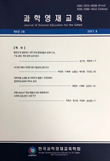잠자리 수채의 사냥 시 아랫입술 움직임에 대한 생체역학적 분석
Biomechanical Analysis of Labial Movement in the Hunting of Dragonfly Nymphs
- 한국과학영재교육학회
- 과학영재교육
- 제15권 제1호
-
2023.04196 - 204 (9 pages)
-
DOI : 10.29306/jseg.2023.15.1.196
- 15

잠자리 수채는 물 속에서 길게 접힌 아랫입술을 순간적으로 뻗어 먹잇감을 낚아챈다. 수채 아랫입술은 그 형태학적 특징에 따라 크게 국자형(scooped)와 주걱형(flat)으로 구분되며 각각의 특징을 가장 잘 대표하는 밀잠자리(O. albistylum) 와 왕잠자리(A. parthenope)를 선정해 연구에 사용하였다. 이번 연구는 수채의 사냥에서 나타나는 생체역학적 특징을 두 가지 아랫입술 형태에 따라 분석하고 비교하는 것을 목표로 했으며 세부 목적에 맞게 나눈 3가지 탐구를 진행했다. 첫째로, 아랫입술구조에 대한 정량적 분석을 위해 아랫입술 해부 후 각 부위의 길이, 질량과 관절 펼침각을 측정했다. 분석 결과, 국자형 아랫입술은 3차원적 구조로 인해 관절 펼침각에 제한이 생김을 확인하였다. 둘째로, 수채의 사냥영상을 Tracker program으로 분석했으며 아랫입술 속도, 가속도와 같은 물리량을 구하였다. 그 결과, 아랫입술을 펼칠 때 밀잠자리는 평균 0.4m/s, 왕잠자리는1.5m/s의 속도를 내는 것을 확인했다. 셋째로, 앞선 탐구 결과를 종합해 두 가지 생체역학적 분석을 시도했다. 사냥 시 아랫입술이 내는 힘의 계산과 사냥 중 아랫입술에 가해지는 물의 저항을 추정한 것이 그 둘이며 각각을 위해 뉴턴 제 2법칙과 감쇠진동 종말속도 식을 사용했으며 왕잠자리가 밀잠자리보다 25배 큰 힘을 내는것을 확인하였다. 이번 연구의 결과로 밀잠자리와 왕잠자리의 사냥 특성에 대한 구체적인 설명을 제시할 수있을 뿐 아니라 선행연구에서 시도된 적 없었던 아랫입술 형태 기반의 생체역학적 분석을 수행한 점에서 의의를 갖는다.
Dragonfly nymphs are known for their ability to rapidly snatch prey by extending their folded labium, despite the resistance of water. The labia of dragonfly nymphs can be categorized into two types based on their shapes: Scooped and Flat. Orthetrum albistylum and Anax parthenope were selected respectively as the most representative species of the scooped and flat labial types. This study aimed to examine the hunting behavior of dragonfly nymphs through analyzing the biomechanical characteristics of the scooped and flat labia and three separate analyses were performed. First, we conducted a quantitative analysis of the labium structures by measuring the length, mass, and joint angle of each part through anatomical dissection. The result showed that the scooped labium has limitations in opening its joints compared to the flat one due to structural difference. Second, we analyzed hunting videos of dragonfly nymph using the Tracker program to measure physical quantities such as velocity and acceleration. The average Striking velocity of the labium is 0.40m/s in O. albistylum and 1.53m/s for A. parthenope. Third, we conducted two additional biomechanical analyses: (1) we calculated the magnitude of the force involved in the strike and (2) we compared the water resistance that the labia encountered during hunting using a second-order differential equation that calculates terminal velocity of damped oscillation. Our findings may suggest that the differences in the biomechanical characteristics of the labia can explain the ecological differences between O. albistylum and A. parthenope. We found out that O. albistylum is better adapted to catching small prey, whereas A. parthenope is more adept at catching larger and faster prey. This study is not only expected to contribute to better understanding of insects, but is also expected to be highly valuable for future research on biomimetic devices.
Ⅰ. 연구의 필요성 및 목적
Ⅱ. 이론적 배경
Ⅲ. 연구방법
Ⅳ. 고찰
Ⅴ. 결론 및 제언
참고문헌
(0)
(0)